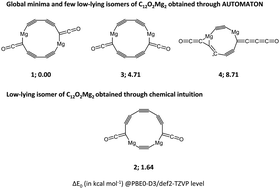Why an integrated approach between search algorithms and chemical intuition is necessary?†
Abstract
Though search algorithms are appropriate tools for identifying low-energy isomers, fixing several constraints seems to be a fundamental prerequisite to successfully running any structural search program. This causes some potential setbacks as far as identifying all possible isomers, close to the lowest-energy isomer, for any elemental composition. The number of explored candidates, the choice of method, basis set, and availability of CPU time needed to analyze the various initial test structures become necessary restrictions in resolving the issues of structural isomerism reasonably. While one could arrive at new structures through chemical intuition, reproducing or achieving those exact same structures requires increasing the number of variables in any given program, which causes further constraints in exploring the potential energy surface in a reasonable amount of time. Thus, it is emphasized here that an integrated approach between search algorithms and chemical intuition is necessary by taking the C12O2Mg2 system as an example. Our initial search through the AUTOMATON program yielded 1450 different geometries. However, through chemical intuition, we found eighteen new geometries within 40.0 kcal mol−1 at the PBE0-D3/def2-TZVP level. These results indirectly emphasize that an integrated approach between search algorithms and chemical intuition is necessary to further our knowledge in chemical space for any given elemental composition.



 Please wait while we load your content...
Please wait while we load your content...
